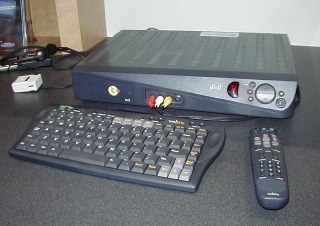
Windows XP is a major release of Microsoft's Windows NT operating system. It was released to manufacturing on August 24, 2001, and later to retail on October 25, 2001. It is a direct upgrade to its predecessors, Windows 2000 for high-end and business users and Windows Me for home users, available for any devices running Windows NT 4.0, Windows 98, Windows 2000 and Windows Me that meet the new Windows XP system requirements.

Windows 95 is a consumer-oriented operating system developed by Microsoft as part of its Windows 9x family of operating systems. The first operating system in the 9x family, it is the successor to Windows 3.1x, and was released to manufacturing on July 14, 1995, and generally to retail on August 24, 1995, almost three months after the release of Windows NT 3.51. Windows 95 merged Microsoft's formerly separate MS-DOS and Microsoft Windows products, and featured significant improvements over its predecessor, most notably in the graphical user interface (GUI) and in its simplified "plug-and-play" features. There were also major changes made to the core components of the operating system, such as moving from a mainly cooperatively multitasked 16-bit architecture to a 32-bit preemptive multitasking architecture, at least when running only 32-bit protected mode applications.

MSN is a web portal and related collection of Internet services and apps for Windows and mobile devices, provided by Microsoft and launched on August 24, 1995, alongside the release of Windows 95.

MSN TV was a web access product consisting of a thin client device that used a television for display, and the online service that supported it. The device design and service was developed by WebTV Networks, Inc., a company started in 1995. The WebTV product was announced in July 1996 and later released on September 18, 1996. In April 1997, the company was purchased by Microsoft Corporation and in July 2001, was rebranded to MSN TV and absorbed into MSN.

Opera is a Norwegian multinational technology company and subsidiary of Kunlun that specializes in web browser development, fintech, as well as services such as Opera News and YoYo Games. The company's total user base, including users of its desktop browsers, mobile browsers and other services exceeds 380 million monthly active users.
In computing, Download.ject is a malware program for Microsoft Windows servers. When installed on an insecure website running on Microsoft Internet Information Services (IIS), it appends malicious JavaScript to all pages served by the site.

Google Video was a free video hosting service launched by the multinational technology company Google on January 25, 2005. Similar to YouTube, this platform allowed video clips to be hosted on Google servers and embedded on to other websites. In 2009, Google Videos stopped accepting new video uploads since Google acquired YouTube, and users had the opportunity to publish their videos directly onto YouTube. On August 20, 2012, Google Videos was ultimately shut down.

Microsoft Internet Explorer 6 (IE6) is a graphical web browser developed by Microsoft for Windows operating systems. Released on August 24, 2001, it is the sixth, and by now discontinued, version of Internet Explorer and the successor to Internet Explorer 5. It was the default browser in Windows XP and Windows Server 2003 and can replace previous versions of Internet Explorer on Windows NT 4.0, Windows 98, Windows 2000 and Windows ME but unlike version 5, this version does not support Windows 95 or an earlier version. IE6 SP2+ and IE7 were only included in or available (IE7) for Windows XP SP2+.

Internet Explorer Mobile is a discontinued mobile browser developed by Microsoft, based on versions of the MSHTML (Trident) layout engine. IE Mobile comes loaded by default with Windows Phone and Windows CE. Later versions of Internet Explorer Mobile are based on the desktop version of Internet Explorer. Older versions however, called Pocket Internet Explorer, are not based on the same layout engine.

Bing Videos is a video search service and part of Microsoft's Bing search engine. The service enables users to search and view videos across various websites. Bing Videos was officially released on September 26, 2007 as Live Search Video, and rebranded as Bing Videos on June 1, 2009.

Zune is a discontinued line of digital media products and services marketed by Microsoft from November 2006 until its discontinuation in June 2012. Zune consisted of a line of portable media players, digital media player software for Windows PCs, a music subscription service known as a "Zune Music Pass", music and video streaming services for the Xbox 360 game console via the Zune Software, music, TV and movie sales, and desktop sync software for Windows Phone. Zune was also the provider of music streaming for United Airlines in-flight, after a partnership in 2010.

The Helio Ocean was a dual slider Internet-enabled multimedia wireless mobile device sold by mobile virtual network operator (MVNO) wireless carrier Helio, and manufactured by Pantech Curitel. A distinctive design feature of the Ocean was its dual sliding mechanism — when slid down in the vertical position, it revealed a telephone keypad. When slid down in the horizontal position, it revealed a 35-key QWERTY keyboard.

Microsoft OneDrive is a file hosting service operated by Microsoft. First launched in August 2007, it enables registered users to share and synchronize their files. OneDrive also works as the storage backend of the web version of Microsoft Office. OneDrive offers 5 GB of storage space free of charge, with 100 GB, 1 TB, and 6 TB storage options available either separately or with Office 365 subscriptions.

Ovi by Nokia was the brand for Nokia's Internet services. The Ovi services could be used from a mobile device, computer or via the web. Nokia focused on five key service areas: Games, Maps, Media, Messaging and Music. Nokia's aim with Ovi was to include third party developers, such as operators and third-party services like Yahoo's Flickr photo site. With the announcement of Ovi Maps Player API, Nokia started to evolve their services into a platform, enabling third parties to make use of Nokia's Ovi services.

Outlook.com is a webmail service that is part of the Microsoft 365 product family. It offers mail, calendaring, contacts, and tasks services.

MSN Messenger, later rebranded as Windows Live Messenger, was a cross-platform instant-messaging client developed by Microsoft. It connected to the Microsoft Messenger service and, in later versions, was compatible with Yahoo! Messenger and Facebook Messenger. Versions were developed for Windows, Xbox 360, Mac OS X, BlackBerry OS, iOS, Java ME, S60 on Symbian OS 9.x, MSN TV, Zune HD, Windows Phone, Windows Mobile and Windows CE.

The Zune HD is a portable media player in the Zune product family released on September 15, 2009, by Microsoft. It was a direct competitor with Apple's iPod Touch series of mobile devices. It was initially released in 16 and 32 GB capacities. A 64 GB version was released on April 9, 2010. It has a touchscreen interface for navigation and included Wi-Fi for synchronization, access to the Zune Marketplace and Web browsing.

Kin was a short-lived mobile phone line from Microsoft designed for users of social networking. The phones, aimed at people between ages 15 and 30, were manufactured by Sharp Corporation and sold through Verizon Wireless.
Microsoft mobile services are a set of proprietary mobile services created specifically for mobile devices, they are typically offered through mobile applications and mobile browser for Windows Phone, | platforms, BREW, and Java. Microsoft's mobile services are typically connected with a Microsoft account and often come preinstalled on Microsoft's own mobile operating systems while they are offered via various means for other platforms. Microsoft started to develop for mobile computing platforms with the launch of Windows CE in 1996 and later added Microsoft's Pocket Office suite to their Handheld PC line of PDAs in April 2000. From December 2014 to June 2015, Microsoft made a number of corporate acquisitions, buying several of the top applications listed in Google Play and the App Store including Acompli, Sunrise Calendar, Datazen, Wunderlist, Echo Notification Lockscreen, and MileIQ.

MSN Dial-up is an Internet service provider operated by Microsoft in the United States and formerly also in several other countries. Originally named The Microsoft Network, it debuted as a proprietary online service on August 24, 1995, to coincide with the release of Windows 95. In 1996 and 1997, a revised web-based version of the ISP was an early experiment at interactive multimedia content on the Internet.
















